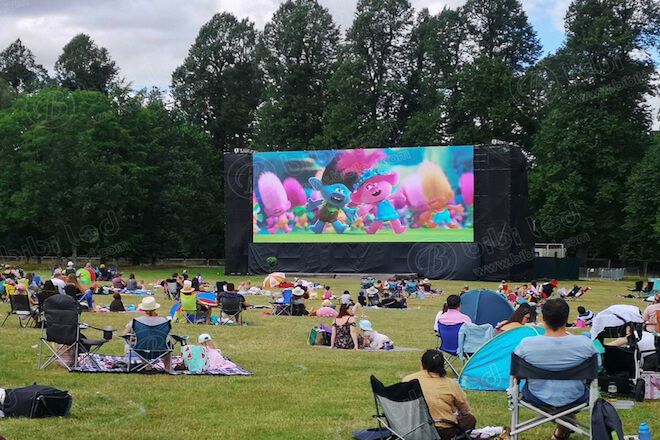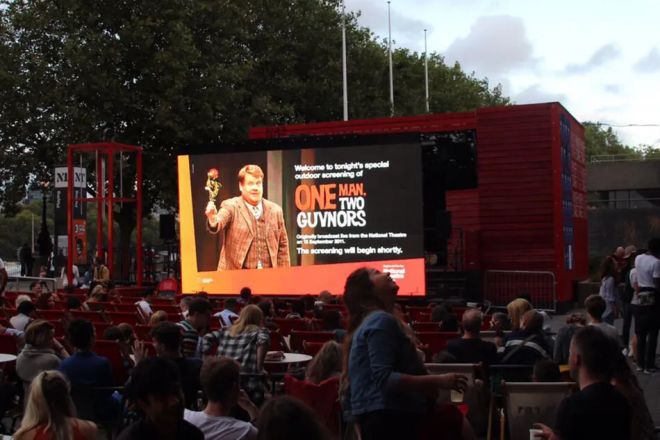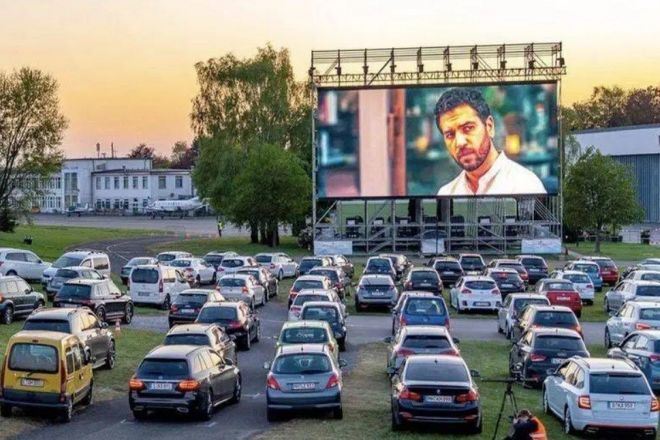Introduction

With the acceleration of the pace of urban life, people are increasingly eager to find a quiet place to enjoy a moment of leisure and relaxation after a busy day. As a unique way of watching movies, open-air cinemas are attracting more and more citizens with their open space, natural atmosphere, and intimate social experience.
However, if an open-air cinema wants to truly bring out its charm, the key lies in choosing a suitable LED display. The brightness, color, stability, and other characteristics of the LED display directly determine the viewing effect of the open-air cinema.
1. Special requirements of open-air cinemas for LED displays
1). Brightness and contrast
Since open-air cinemas are located in outdoor environments, the interference of natural light will have a greater impact on the viewing effect. Therefore, the LED display needs to have a high enough brightness to ensure that the picture can still be clearly seen under direct sunlight or strong light conditions. A high-brightness LED display can ensure that the audience is not disturbed by light during the viewing process and gets a better viewing experience.
Contrast refers to the brightness ratio of the brightest part to the darkest part of the picture, which is crucial to presenting the details and layering of the picture. In an open-air cinema, the audience’s sight is easily affected by the surrounding environment because the viewing environment is relatively open. Therefore, the LED display needs to have a high contrast ratio to present richer details and layering in dark scenes so that the audience can feel a more realistic and three-dimensional picture effect during the viewing process.
2). Weather resistance and stability
- Weather resistance:
The LED display screen of the open-air cinema needs to withstand the test of various outdoor environments, such as high temperature, low temperature, humidity, dust, etc. These environmental factors may affect the performance and life of the LED display screen. Therefore, the LED display screen needs to have excellent weather resistance and be able to maintain stable performance and long service life in various harsh environments.
- Stability:
There are usually more audiences gathered in open-air cinemas, so the LED display screen needs to run stably for a long time to ensure that the viewing process is not disturbed. A stable LED display screen can reduce the failure rate and maintenance costs, and provide the audience with a smoother and more comfortable viewing experience.
3). Resolution and size
Resolution is an important indicator of LED display screens, which determines the clarity and delicacy of the picture. In an open-air cinema, the distance between the audience and the screen is usually far, so it is necessary to choose an LED display with a higher resolution to ensure that the picture remains clear when viewed from a distance.
A high-resolution LED display can present a more delicate and realistic picture effect, allowing the audience to have a more immersive experience during the viewing process.
- Size:
The audience size of an open-air cinema is usually large, so it is necessary to choose an LED display with a larger size to ensure that the picture can cover a wider audience range. A large LED display can provide a more shocking and realistic viewing effect, allowing the audience to feel a stronger visual impact and immersion during the viewing process.
2. Types of LED displays suitable for open-air cinemas

1). Outdoor high-brightness LED display
- High-brightness design:
Outdoor high-brightness LED displays are designed for outdoor environments and have extremely high brightness output, ensuring that the picture can still be clearly seen under direct sunlight or other strong light interference. This high-brightness design allows open-air cinemas to provide an excellent viewing experience during the day or night.
- Excellent weather resistance and stability:
Outdoor high-brightness LED display screens are made of special materials and processes, have excellent weather resistance and stability, and can withstand harsh environments such as high temperature, low temperature, humidity, sand, and dust. At the same time, its internal heat dissipation system and power management system have also been carefully designed to ensure long-term stable operation and reduce the failure rate.
- Lightweight, easy to build and disassemble:
Rental LED display screens usually adopt modular design, and each module has an independent power supply and control unit, making the entire display screen light and easy to build and disassemble. This design is very suitable for temporary places such as open-air cinemas and can be quickly built and dismantled as needed.
- Equipped with accessories such as transport boxes and brackets:
In order to facilitate transportation and installation, rental LED display screens are usually equipped with accessories such as transport boxes and brackets. These accessories not only ensure the safety of the display screen during transportation but also make the installation process simpler and faster.
3). Flexible LED display screen
- Bendable and deformable design:
Flexible LED display screens have bendable and deformable characteristics and can be customized and installed according to the shape of the venue. This design enables the display screen to better adapt to the needs of irregular venues such as open-air cinemas, achieving seamless fit and perfect integration.
- Unique visual effects:
The uniqueness of flexible LED display screens lies in their softness and deformability, which can create a variety of unique visual effects. In open-air cinemas, these characteristics of flexible LED display screens can be used to design various creative shapes and dynamic effects, bringing audiences a more colorful viewing experience.
3. Factors to consider when choosing LED display screens
1). Budget
- Model and configuration:
Within a limited budget, you should choose LED display screen models and configurations with stable performance and reasonable prices. Considering that the price of LED display screens may vary depending on factors such as brand, model, and size, you need to weigh it according to your own budget range.
- Long-term operating costs:
In addition to the purchase cost, you also need to consider the long-term operating costs of LED display screens, including energy consumption, maintenance costs, etc. Choosing a display screen with high energy efficiency and low maintenance costs will help reduce long-term operating costs.
2). Brand and quality
- Well-known brand:
Choosing LED display screen products from well-known brands can ensure the reliability of product quality and after-sales service. Well-known brands usually have a long market history and a good reputation, and their products have certain guarantees in terms of technology, quality, and service.
- Reliable quality:
When choosing an LED display screen, you should pay attention to the quality and stability of the product. Reliable quality display screens can reduce failure rates and maintenance costs, ensuring a smooth viewing process.
- After-sales service and technical support:
Understand the supplier’s after-sales service and technical support to ensure timely help and support during the use of the display screen. This includes services such as repair, maintenance, and upgrades.
3). Site conditions
- Size and shape:
Choose a suitable LED display screen according to the size and shape of the venue. Ensure that the display screen can be installed in a suitable location while meeting the viewing needs of the audience.
- Environmental conditions:
Consider the environmental conditions of the venue, such as temperature, humidity, wind, etc. Choose an LED display screen that can adapt to these environmental conditions to ensure its stability and service life.
- Visual effects:
Ensure that the LED display screen can be installed in a suitable location for the best visual effects. This includes considering factors such as the audience’s viewing angle and viewing distance to ensure that the picture can be presented clearly to the audience.
4). Audience needs
- Resolution and size:
Choose the appropriate LED display screen resolution and size according to the audience size and viewing needs. High-resolution and large-size display screens can provide a better viewing experience, but factors such as cost and site conditions also need to be considered.
- Viewing distance and viewing angle:
Consider the audience’s viewing distance and viewing angle to ensure that the picture can be presented clearly to the audience. When choosing an LED display, you need to consider factors such as the distance between the audience and the screen and the viewing angle of the audience.
4. Points worth noting

When choosing an LED display suitable for an open-air cinema, in addition to the factors mentioned above, there are some points that deserve special attention. The following will be expressed and summarized in points:
1). Brightness and contrast
High brightness: The light in the outdoor environment is complex, and at least 6000 nits or higher brightness is required to ensure that the picture is still clearly visible under direct sunlight.
Contrast: The higher the contrast, the richer the layering of the picture, especially in dark scenes; it can better present details.
2). Weather resistance and stability
Protection level: Choose a display with IP65 or higher protection level to ensure its waterproof and dustproof properties, and adapt to various harsh outdoor environments.
Working temperature: Select integrated circuit chips with an operating temperature between -40℃ and 80℃ to ensure that the display can work normally in extreme climates.
3). Heat dissipation design
Thermal conductive material: Fill the display with thermal conductive material to help heat transfer from the inside to the outside.
Heat dissipation device: Install a heat dissipation device, such as a fan or liquid cooling system, to enhance internal heat dissipation.
Aluminum heat sink fins: Design aluminum heat sink fins on the display housing to increase the heat dissipation area.
4). Resolution and size
Ideal ratio: According to the venue and audience size, choose a 16:9 or 4:3 display ratio to get the best viewing effect.
Large size: For open-air cinemas, large-size displays can cover a wider audience range, but cost and venue conditions must also be considered.
5). Color performance
Color reproduction ability: Ensure that the LED display has excellent color reproduction ability to present the true color of the picture.
Color gamut range: Choose a display with a wide color gamut range, which can display more colors and enhance the viewing experience.
6). Easy maintenance and intelligent control
Easy maintenance: Choose a display with easy module replacement and a convenient front maintenance design so that problems can be quickly repaired.
Intelligent control: Use an intelligent control system to automatically adjust the brightness of the display according to the ambient light, save energy, and reduce light pollution.
7). Installation stability and safety
Installation stability: Ensure that the display is firmly installed to resist the influence of natural forces such as strong winds. Regularly check the stability of the fixed structure to ensure the safety of the display.
Fire safety: Consider the fire safety of the venue and ensure that the installation and use of the display comply with relevant safety regulations.
8). Cost control and long-term operation
Purchase cost: Choose the appropriate display model and configuration according to your own budget, and avoid blindly pursuing high-end configurations to increase costs.
Long-term operating cost: Consider the long-term operating costs such as the energy consumption and maintenance costs of the display, and choose a display with high energy efficiency and low maintenance cost.
Conclusion
Through the discussion of LED display screens suitable for open-air cinemas, it is not difficult to find that choosing a suitable LED display screen is crucial to improving the viewing experience of open-air cinemas.
From brightness, color, and stability to weather resistance, each indicator affects the audience’s viewing experience. Therefore, when choosing an LED display screen, we need to comprehensively consider factors such as budget, brand, venue conditions, and audience needs to ensure that the selected product meets the actual needs of the open-air cinema.
Finally, if you want to know more about LED display screens, please get in touch with us.
